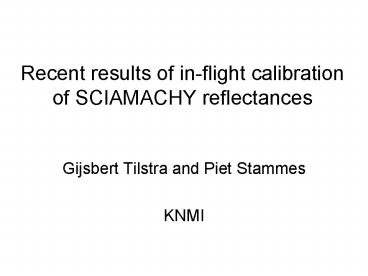Recent results of inflight calibration of SCIAMACHY reflectances - PowerPoint PPT Presentation
1 / 15
Title:
Recent results of inflight calibration of SCIAMACHY reflectances
Description:
Cloud algorithm (e.g. FRESCO) Absorbing aerosol index algorithm ... Reflectance corrections applied. AAI: 340 nm: 1.21. 380 nm: 1.13. FRESCO: 760 nm: 1.20 ... – PowerPoint PPT presentation
Number of Views:25
Avg rating:3.0/5.0
Title: Recent results of inflight calibration of SCIAMACHY reflectances
1
Recent results of in-flight calibration of
SCIAMACHY reflectances
- Gijsbert Tilstra and Piet Stammes
- KNMI
2
Reflectance
- Reflectance
- p Earth radiance / solar irradiance at TOA
- p I / µ0 E0
- The reflectance is the basic L1 quantity needed
for retrieval of L2 products.
3
Absolute radiometric calibration of the
reflectance is needed for e.g.
- Nadir ozone profile algorithm
- Cloud algorithm (e.g. FRESCO)
- Absorbing aerosol index algorithm
- Aerosol optical thickness algorithm
- Surface albedo algorithm
4
Approach of in-flight reflectance calibration
- 1. Use a radiative transfer model in the UV,
where Rayleigh scattering and ozone absorption
are determining the signal, which can be
accurately computed - 2. Compare reflectances with other satellite
instruments - MERIS
- GOME
- POLDER
5
SCIAMACHY vs RTM (DAK) in the UV (240400 nm)
(old key data)
orbit 2509, 23-08-2002, SV 5.00
orbit 11251, 25-04-2004, SV 5.04
orbit 13028, 27-08-2004, SV 5.04
Tilstra et al., JGR 110, in press,
doi10.1029/2005JD005853, 2005.
6
Alternative radiative transfer comparison
- Large-scale comparison between reflectances from
SCIAMACHY and an RTM (LidortA, polarization
corrected) by Van Soest et al. (Atmos. Chem.
Phys., 5, 2171-2180, 2005) gives - RSCIA RRTM -20 5 for 250 400 nm.
7
SCIAMACHY vs MERIS
Acarreta Stammes, GRSL 2, 3135,
doi10.1109/LGRS.2004.838348, 2005.
Acarreta et al., KNMI Internal Report, 3 November
2004.
(old and new key data)
MERIS spectral bands 442, 510, 665, 708, 885 nm
8
SCIAMACHY vs GOME
(old key data)
- strong (scan-angle dependent) degradation of
GOME in the UV up to 500 nm. - above 500 nm no scan-angle dependency result
accurate. - result above 500 nm agrees with MERIS comparison.
Tilstra et al., Appl. Opt, submitted, 2005.
9
SCIAMACHY vs POLDER
(old key data)
Summarized all comparisons point to the same
1520 calibration error in the reflectance
10
Reflectance ratio R(new key data) / R(old key
data)
This ratio is fully determined by the new key
data irradiance. This ratio is the same for all
scenes, because the radiance appears to be
unchanged (!) with the new key data.
11
All information put together
At higher wavelengths no agreement between the
effect of new key data and the reflectance
comparisons with other satellite instruments.
12
Spectral features
The new key data introduces spectral features in
the reflectance. Effect on level-2 (DOAS)
retrievals unknown.
13
Why the new key data is not the solution
- It does not correct the reflectance error for
wavelengths gt 600 nm. - It introduces new spectral features, especially
between 340 and 400 nm, whereas we know from
GOME, OMI and UV RTMs that the continuum spectrum
there should be straight.
14
Conclusions
- The new key data does not solve the calibration
error of the reflectance, esp. at longer ?. - The new key data adds nonphysical spectral
features to the reflectance, esp. at shorter ?. - For the time being it seems better to apply a
spectrally smooth empirical correction of the
reflectance spectra produced with the old key
data, based on in-flight calibration.
15
Reflectance corrections applied
- AAI 340 nm 1.21
- 380 nm 1.13
- FRESCO 760 nm 1.20































